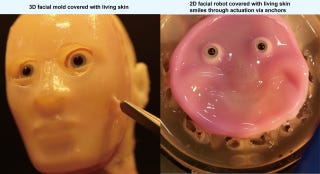Every edition features 7 stories, from the past week. I’ll draw on my background in media, journalism, agriculture, biotech, and renewable energy to come up with an interesting selection and to offer some context.
While researching a short story I’m writing, I found a good news biodiversity story from Doñana National Park in Spain.
Couldn’t resist adding it to this week’s newsletter so say hello to the comeback kitty.

Doñana National Park is home to the Iberian Lynx and 20 years ago it was on the brink of extinction. The International Union for Conservation of Nature announced the species has graduated to ‘Vulnerable’. According to the Washington Post a veterinarian with the LIFEW Lynx-Connect project said they are “…more optimistic about the future”. The Vulnerable classification means there is still a risk of extinction given the current population is still fewer than 2,000 animals. Even with that caveat it is being seen as the greatest conservation recovery of a cat species if you keep in mind there were only 60 of them in Portugal and Spain in 2002.
The Iberian lynx was once prevalent in Spain's Doñana National Park but started to lose ground through habitat loss, hunting, and a rapid decline in its main prey, the European rabbit. By protecting the habitat of the rabbit, the remaining lynx started to have a fighting chance. The toughest step was to get local hunters and farmers to understand the importance of the species. Offering farmers compensation for livestock lost to the lynx was part of the process. Captive breeding programs helped add 200 lynx to the natural stock.
Compounding the problems for the lynx and the rabbit populations is the deterioration of Doñana National Park. It is a 54,000-hectare wetland park on the Guadalquivir River where it empties into the Atlantic (the area I was actually researching when I came across the story). Agricultural and urban use has been affecting the quantity and quality of the water in the park to the point where the Court of Justice of the European Union condemned Spain in 2021 for not preserving the area. Little has been done by Spain to address those concerns but heavy rains earlier this year have helped revive at least some areas within the park.
Without some action to protect Doñana, waterfowl, amphibians, fish, plants, and animals such as Iberian lynx will continue to be put at risk.
I use fake meat regularly. Depending on the recipe, you would be hard pressed to know that it contained no ground beef and instead relied on a plant-based substitute. The problem with these alternative forms of protein is that they are ultraprocessed to improve flavour or extend shelf life. Ultraprocessed foods are not just washed, canned, or pasteurized, they have had some serious work done to change them into something for the table. Your nuggets made from real chicken and my ground beef that has never seen a cow are both ultraprocessed, and a study published in Lancet Regional Health–Europe earlier this month suggested they are not good for your health. Many journalists and bloggers jumped on the story and concluded that fake meat products were bad for you. CNN for instance went straight to the “early death” scenario.
A story this week in Scientific American however said it is not as straightforward as it seems. While the study did include plant-based meat it also included beverages such as vodka. Certainly ultraprocessed, and none of the subsequent stories I read recommended pouring your Grey Goose down the drain. Bread, cakes, and ketchup were also in the plant-based category, because let’s face it, all those foods started with a plant-based source. However, if you were asked, I doubt if you would likely put them in the same category as meat substitutes.
The Lancet study was an observational study where people were given questionnaires and asked to recall their diet choices. While there may be observational links to diet and disease, a much more detailed follow-up experimental study would be needed to make direct links. If you are wondering whether you should ditch your fake meat, stick with a balanced diet and until we hear more, don’t worry about the alt-meat.
Meanwhile development of plant-based alternatives continues. Researchers at the University of Guelph are working on cheaper ways to produce commercial products because right now when it simply comes down to cost, fake meat loses to the real thing. They are using a “mechanical mouth” as part of the R & D, to help develop textures closer to real beef. A National Post story this week said that when real mouths took part in a blind tasting, plant-based chicken nuggets beat the genuine product. (note that the survey was conducted by an alt-protein nonprofit)
Which raises a new level of complexity to the ages old question. Which came first, the chicken, the egg, or the plant?
The Painted Lady Butterfly has a wingspan of 5 to 9 cm (2 to 3.5 inches). Like other butterflies it goes through 4 stages of growth: egg, larva (caterpillar), pupa (chrysalis), and finally the adult butterfly. It is that adult Painted Lady Butterfly that made the headlines thanks to a study published in Nature Communications, on how these butterflies with a wingspan about the length of my index finger made it from West Africa to French Guiana in South America. A non-stop journey of more than 4,200km (2,600 miles) across the Atlantic Ocean. One of the co-leads in the study was Clément Bataille, an associate professor in the Department of Earth and Environmental Sciences at the University of Ottawa.
It all got started when a biologist found a flock of the little butterflies sitting on the sand in French Guiana in 2012 looking somewhat the worse for wear. This butterfly is found in various places around the world, but never seen in South America before.
Using genome sequencing, the researchers were able to determine the connection to African and European populations, and the DNA from the pollen grains stuck to the butterflies matched plant species which only grow in Africa. Isotope matching revealed that the butterflies probably started the journey somewhere in Europe, so the total journey was even longer than the transatlantic leg of their flight.
The migration was helped by favourable winds, but it is still an incredible feat. The Painted Lady was already a record holder of sorts after British researchers said in 2018 that the circular migration from Europe to the Afrotropics was the longest recorded round-trip journey. Now these tiny insects can add the first known hop across the Atlantic to their trophy case.
Sitting on the shelf behind me is the latest Associated Press Stylebook, a publication which has been around since 1953. AP is a US not-for-profit news syndication organization and you have probably read many of their stories without ever realizing it. In a changing news environment, AP has managed to provide accurate reporting to a struggling industry.
AP has taken another step in supporting journalism and announced the launch of a charitable organization to expand news gathering and reporting in the US. The AP Fund for Journalism still needs IRS approval but has already started its drive to raise $100 million for the project.
According to Axios, with the 2024 election on the horizon, AP is establishing new partnerships with local newsrooms to distribute more content. As the article points out, AP has a significant local presence and has at least one reporter in every US state capital.
Canada is addressing similar problems with programs such as the Local Journalism Initiative which provides funding to hire reporters to cover underserved communities. Four out of five Canadians read newspaper content every week on some platform (print, website, tablet, or phone) but you might be surprised to know that there are still 28 million newspaper distributed across the country according to News Media Canada.
Finding the ideal business model (or a mix of models) to keep newspaper journalism off life support is no easy task. The Saltwire network in Atlantic Canada has filed for protection from creditors. I subscribe to the digital network and its journalism and range of stories is certainly not a problem. The price is reasonable, but jacking up rates is not a solution either. All the content is behind a paywall and cannot be shared in any manner which is unlike most other news paywalls. Even the New York Times offers some free stories, and subscribers get a monthly allotment of free shareable links. Saltwire however is less a paywall and more of a fortress. Regular readers of this newsletter have benefited from my gift links to several news sites but have never seen a link to a Saltwire story because there is no way to share it. That means you also don’t see the advertisements, so Saltwire loses out in the long run.
Local and regional news is important and there are ways to address the challenges as you’ll hear in this discussion at the Canadian Association of Journalists' national annual conference this year.
As one of the guests in the discussion said, “…long live local journalism”.
No need to stop going for a walk around your neighbourhood, but you do need to keep your eyes off the phone and pay attention the traffic around you when you are in pedestrian mode. In the United States, pedestrian deaths from being hit by a vehicle are going up according to a Wall Street Journal story. Not surprisingly, those fatal encounters dropped during the pandemic, but the Governors Highway Safety Association says the latest numbers are up from pre-pandemic levels. Those numbers had already increased more than 75% between 2010 and 2022. In Canada the statistics are not as dramatic, but they are up and there are notable hotspots. (I found I frustrating that current numbers are maddeningly hard to find).
For instance, February of this year was the most dangerous month since 2020 for all my pedestrian and cycling friends in Toronto. A York University study earlier this year found that between 2016 and 2021, more than 9,700 pedestrians ended up in emergency after suffering an injury on Toronto streets. These numbers come even after Toronto initiated a Vison Zero 2.0 plan in 2019 to reduce traffic-related injuries and deaths in the city. In 2023 The Canadian Centre for Economic Analysis looked at data for 2019 (back to my comment above about the lack of statistics) and said that the social cost of collisions across the country was more than $44 million dollars. About 2% of Canada’s GDP for that year.
To cap things off there are 2 surveys that add a troubling dimension to the problem.
The latest is a Leger poll done for Ratesdotca which is an insurance rates comparison and aggregator site. According to a Global News story, 83% of the respondents said they had witnessed road rage over the last year. That was up 5 percentage points from last year.
A survey done by Parachute, a national charity focused on injury prevention found that while most Canadians agree that road safety in their communities is important, their attitudes don’t necessarily reflect that. Compared to previous surveys, fewer believe it is unacceptable to use hands-free while driving or that drivers should take extra precautions around cyclists. The views on texting while driving, taking stimulants, aggressive driving, and using cannabis have softened as well.
To borrow from Hill Street Blues, “let’s be careful out there”
Here is another nightmare for you.
That’s a picture guaranteed to get your attention. The nightmare comes when you realise that it is engineered skin affixed to an underlying artificial structure, much like what you would expect on a new generation of robots.
The new technique was announced in a media release from the University of Tokyo this week and in a paper published in the open access, peer-reviewed journal Cell Reports Physical Science. The researchers were able to mimic the skin-ligament structures and natural flexibility of skin, instead of previous techniques that resulted in damaged ‘skin’ during motion.
TechCrunch said that this is an experiment and “will not be the face of your next smart home hub or vacuum”. I’m not so sure, because we have been putting human faces to our robots and mechanical devices since they were first imagined.
When Czechoslovakian writer Karel Čapek introduced the word robot in 1920 he saw them as having human faces and they were able to walk, talk, and even fight.
The first robot depiction in movies was Futura in Fritz Lang’s silent movie, Metropolis. She did not have the full human look we would see later in movies such as Westworld but the first steps had been taken.
Westinghouse built the Televox robot in 1929 with the cheesy appearance of a B-science fiction movie but it had a ‘face’.

In 1928 Gakutensoku appeared on the scene in Japan with rubber facial features that moved.
A 450-year old mechanical monk looks like, well, a monk, and moves its mouth as if in prayer
The Draughtsman-Writer automaton built by Henri Maillardet in 1800 moved its lifelike head, eyes, and hands to draw and to write.
When we set out to mimic the actions of people through mechanical wizardry, we tend to want them to look like us as well.
The etymology of Čapek’s robot was ‘robota’, meaning “forced labour” and maybe that is really what we are after, slavery without any of the social consequences.
Summer is out to get you as more ticks come armed with the Anaplasma phagocytophilum bacteria. As we kicked off the 2000s there were only a handful of cases of anaplasmosis in Canada and now we’re seeing up to 500 cases per year according to a CBC story. Anaplasmosis infects while blood cells in people (and animals) and you’ll know it from the fever, chills, headache, and fatigue you experience after being bitten by a tick. Respiratory failure, anemia, liver disease and death may occur in the immunocompromised, children and the elderly.
It is spread by the same black-legged tick which spreads Lyme disease.
We hear about black-legged ticks (often referred to as deer ticks) every year as summer approaches, but just how well do you know this little critter. We have more than 40 different kinds of ticks in Canada and while the most worrisome right now is the black-legged variety they all seem to be capable of spreading bacteria of some kind.
A typical tick life cycle goes from egg to larva and then nymph to adult and every stage requires blood to promote development. And they like to take their time for that meal which is why they are so good at remaining attached. Here is what the nymph looks like under a microscope – not a very handsome fellow at all.
They can however, go for long periods with no food. Which is good for the tick because there are a lot of them competing for your blood. With climate change comes more improved tick habitat which means they are more prevalent, live longer, and reproduce more. In addition, researchers estimate between 50 million and 175 million, hitch a ride with migratory birds crossing the 49th parallel every spring. They are also pretty good at adapting to a range of hosts such as amphibians and reptiles when they can’t find a bird or a mammal.
Canada is such a good place for ticks to hang out, we even a tick-born virus named after Powassan, Ontario where it was first discovered. There are no approved medications or vaccinations for Powassan virus infections, but for the moment it is relatively rare with only 25 confirmed cases since it was first identified. Symptoms include flu-like fever, nausea, confusion, lack of balance, seizures, and paralysis.
School is out and Canada Day is upon us so put on your hazmat suit and enjoy the summer.
Read, comment, subscribe, and share this newsletter.
I’m available for contract and freelance work with not-for-profits and charities. With 40 years of experience behind me and lots of time ahead of me, I’m here to help you make a difference in your media relations, public relations, and general communications needs.




